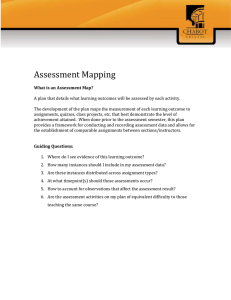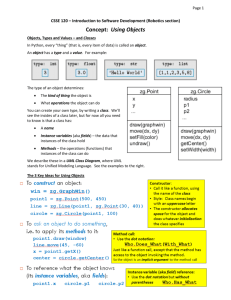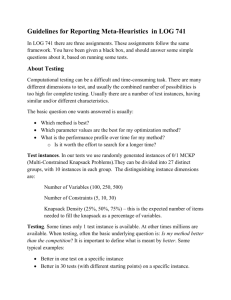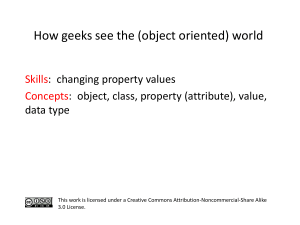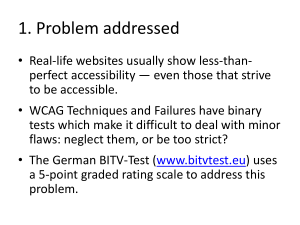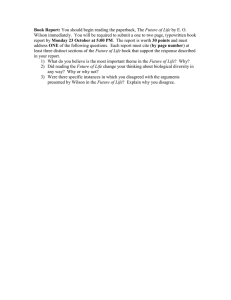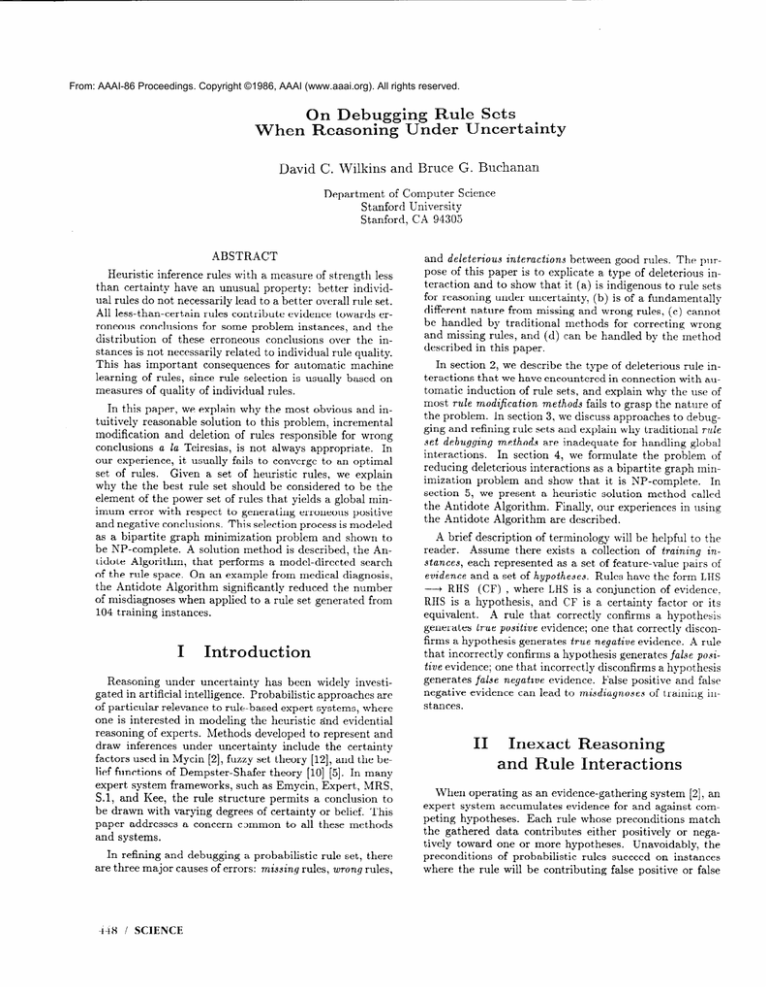
From: AAAI-86 Proceedings. Copyright ©1986, AAAI (www.aaai.org). All rights reserved.
When
On Debugging
Rule Sets
Reasoning
Under Uncertainty
David
C. Wilkins
and Bruce
G. Buchanan
Department
of Computer
Science
Stanford University
Stanford, CA 94305
ABSTRACT
Heuristic
inference
rules with a measure
than certaint,y have an unusual property:
ual rules do not necessarily lead to a better
of strength
less
better individoverall rule set.
All less-than-certain
rules contribute evidence towards erroneous conclusions for some problem instances, and the
distribution
of these erroneous
conclusions
over the instances is not necessarily related to individual rule quality.
This has important
consequences for automatic
machine
learning of rules, since rule selection is usually based on
measures
of quality
In this paper,
tuitively
of individual
we explain
reasonable
rules.
why the most obvious
solut,ion to this problem,
and in-
incremental
modification
and deletion of rules responsible for wrong
conclusions
a la Teiresias, is not always appropriate.
In
our experience,
it usually fails to converge to an optimal
set of rules.
Given a set of heuristic rules, we explain
why the the best rule set should be considered to be the
element of the power set of rules that yields a global minimum error with respect to generating erroneous positive
and negative conclusions. This selection process is modeled
as a bipartite graph minimization
problem and shown to
be NP-complete.
A solution method is described, the Antidote Algorithm,
that performs a model-directed
search
of the rule space, On an example from medical diagnosis,
the Antidote
Algorithm
significantly
reduced the number
of misdiagnoses
when applied to a rule set. generated from
104 training instances.
I
widely investiapproaches are
systems, where
one is interested in modeling the heuristic tind evidential
reasoning of experts. Methods developed to represent and
draw inferences
under uncertainty
include the certainty
factors
used in Mycin
[23, fuzzy
set theory
[12], and the be-
lief functions of Dempster-Shafer
theory [lo] [5]. In many
expert system frameworks,
such as Emycin, Expert, MRS,
S.l, and Kee, the rule structure permits a conclusion to
be drawn with varying degrees of certaint,y or belief. This
paper addresses a concern common to all these methods
and systems.
In refining
and debugging
are three major
448
/ SCIENCE
a probabilistic
causes of errors:
In section 2, we describe the type of deleterious rule interactions that we have encountered in connection with automatic induction of rule sets, and explain why the use of
most rule modification
methods fails to grasp the nature of
the problem.
In section 3, we discuss approaches to debugging and refining rule sets and explain why traditional
rule
set debugging
methods are inadequate for handling global
interactions.
In section 4, we formulate
the problem of
reducing deleterious interactions as a bipartite graph minimization
problem and show that it is NP-complete.
In
section 5, we present a heuristic solution method called
the Antidote
the Antidote
Algorithm.
Algorithm
rule set, there
missing rules, wrong rules,
Finally, our experiences
are described.
in using
A brief description of terminology
will be helpful to the
reader.
Assume there exists a collection
of training
instances, each represented
as a set of feature-value
pairs of
evidence
and a set of hypotheses.
Rules have the form
+
RHS (CF) > where LHS is a conjunction
RHS is a hypothesis,
and CF is a certainty
LHS
of evidence,
factor or its
equivalent.
A rule that correctly
confirms a hypothesis
generates true positive evidence; one that correctly disconfirms a hypothesis
Introduction
Reasoning
under uncertainty
has been
gated in artificial intelligence.
Probabilistic
of particular relevance to rule-based expert
and deleterious interactions between good rules. The purpose of this paper is to explicate a type of deleterious interaction and to show that, it (a) is indigenous to rule sets
for reasoning under uncertainty,
(b) is of a fundamentally
different nature from missing and wrong rules, (c) cannot
be handled by traditional
methods for correcting
wrong
and missing rules, and (d) can be handled by the method
described in this paper.
generakes
true negative
evidence.
,4 rule
that incorrectly
confirms a hypothesis generates false po,sitive evidence; one that incorrectly disconfirms a hypothesis
generates false negative evidence.
False positive and false
negative evidence can lead to misdiagnoses
of training instances.
II
Inexact
a.nd Rule
Reasoning
Interact ions
When operating as an evidence-gathering
system [2], an
expert system accumulates evidence for and against competing hypotheses.
Each rule whose preconditions
match
the gathered
data contributes
either positively
or negatively toward one or more hypotheses.
Unavoidably,
the
preconditions
of probabilistic
rules succeed on instances
where the rule will be contributing
false positive or false
negative
evidence
the following
for conclusions.
For example,
consider
rule:’
or implicitly
built into rule induction programs;
this policy should be followed as much as possible. Specialization
produces
Rl:
Surgery=Yes
=+ Klebsiella=Yes
(0.77)
The frequency
with which Rl generates false positive
evidence has a major influence on its CF of 0.77, where
- 1 5 CF 5 1. Indeed, given a set of training instances,
such as a library of medical cases, the certainty factor of a
rule can be given a probabilistic
interpretation2
as a function Q(sr, x2, us), where xi is the fraction of the positive
instances of a hypothesis where the rule premise
thus contributing
true positive or false negative
succeeds,
evidence;
22 is the fraction of the negative instances of a hypothesis
where the rule premise succeeds, thus contributing
false
positive or true negative evidence; and 5s is the ratio of
positive instances of a hypothesis
to all instances in the
training set. For Rl in our domain, @(.43, .lO, .22) = 0.77,
because statistics on 104 training instances yield the following values:
x1:
LHS true among
positive
x2:
LHS true among
negative
instances
x3:
RHS true among
all instances
= lo/23
instances
= 8/81
= 23/104
Hence, Rl generates false positive evidence on eight instances, some of which may lead to false negative diagnoses. But whether they do or not depends on the other
rules in the system; hence our emphasis on taking a global
perspective.
The usual method of dealing with situations
such as this is to make the rule fail less often by specializing
its premise [8]. F or example, surgery could be specialized
to neurosurgery,
R2:
and we could replace
Neurosurgery=Yes
+
instances
a rule with a large CF is more likely to have its erroneous
conclusions lead to misdiagnoses.
This perspective
motivates the prevention
of misdiagnoses
in ways other than
the use of rule specialization
or generalization.
Besides rule modification,
another way of nullifying the
incorrect inference of a rule in an evidence-gathering
system is to introduce a counteracting
rules. In our example,
this would be rules with a negative CF that concludes Klebsiella on the false positive training instances that lead to
misdiagnoses.
But since these new rules are probabilistic,
they introduce false negatives on some other training instances, and these may lead to misdiagnoses.
We could
add yet more counteracting
rules with a positive CF to
nullify any problems caused by the original counteracting
rules, but these rules introduce false positives on yet other
training instances, and these may lead to other misdiagnoses. Also, a counteracting
rule is often of less quality
in comparison
to rules in the original rule set; if it were
otherwise the induction program would have included the
counteracting
rule in the original rule set. Clearly, adding
counteracting
rules may not be necessarily the best way of
dealing with misdiagnoses
made by probabilistic
rules.
III
Debugging
and Rule
to be R2 on the grounds
that
Rl
a misdiagnosis
is not always appropriate;
objections
to this frequent practice.
First,
Rule
Sets
Interact ions
Assume we are given a set of probabilistic
rules that were
either automatically
induced from a set of training cases
for the R2 rule,
$(.26, .02, .22) = 0.92, so R2 makes erroneous inferences
in two instances instead of eight.
Nevertheless,
modifying Rl
Third,
instances will be now harder to counteract when they contribute to misdiagnoses
because R2 is stronger. Note that
with:
(0.92)
of training
such a policy.
tion of Rl to R2, can be viewed as creating a potentially
more dangerous rule. Although
it only makes an incorrect inference in two instead of eight instances, these two
A GramNeg_Infection=Yes
Klebsiella=Yes
On our case library
Rl
a rule that usually violates
if the underlying problem for an incorrect diagnosis is rule
interactions,
a more specialized rule, such as the specializa-
A GramNeglnfection=Yes
contributes
to
we offer three
both rules are
inesuct rules that offer advice in the face of limited information,
and their relative accuracy and correctness is
or created manually by an expert and knowledge engineer.
In refining and debugging this probabilistic
rule set, there
are three major
causes of errors:
missing rules, wrong rules,
and unexpected
interactions
among good rules. We first
describe types of rule interactions,
and then show how the
traditional
approach
to debugging
is inadequate.
explicitly
represented by their respective CFs. We expect
them to fail, hence failure should not necessarily lead to
their modification.
Second, all probabilistic
rules reflect
A.
a trade-off between generality
general rule provides too little
interactions.
Rules interact by chaining together, by using
the same evidence for different conclusions, and by drawing
the same conclusions
from different collections of evidence.
and specificity.
discriminatory
An overly
power, and
a overly specific rule contributes too infrequently
to problem solving.
A policy on proper grain size is explicitly
‘This
is a simplified
form of (%And (Same Cntxt Surgery))
j (Conclude
Cntxt Gram-Negative-l
Klebsiella
Tally 770).
2See Appendix
1 for a descripticn
of the function
a. This statistical
interpretation
of CFs deemphasizes
incorporating
orthogonal
utility
measures
as discussed
in [2].
Types of rule interactions
In a rule-based
system,
there
are many
types
of rule
Thus one of the lessons learned from research on MYCIN
[2] was that complete modularity of rules is not possible to
achieve when rules are written manually.
An expert uses
other rules in a set of closely interacting
rules in order to
define a new rule, in particular to set a CF value relative
to the CFs of interacting
rules.
LEARNING
I 449
Automatic
rule induction
systems encounter the same
Moreover,
automatic
systems lack an underproblems.
standing of the strong semantic relationships
among concepts to allow judgements
about the relative strengths of
evidential support.
Instead, induction systems use biases
to guide the rule search [8] [3]. Examples of some biases
used by the induction subsystem of the Odysseus apprenticeship learning program are rule generality,
whereby a
rule must cover a certain percentage
of instances;
rule
specificity,
whereby
a rule must be above a minimum
discrimination
threshold;
rule colinearity,
whereby rules
must not be too similar in classification
in the training set; and rule simplicity,
mum bound
is placed
disjunctions
[3].
on the number
of the instances
whereby a maxi-
of conjunctions
and
cope with deleterious
interactions.
The second methodological problem is that the traditional
method picks an
arbitrary case to run in its search for misdiagnoses.
Such
a procedure will often not converge to a good rule set, even
if modifications
are restricted to rule deletion. Example 2
in section 5.B illustrates this situation.
Our perspective on this topic evolved in the course of experiments in induction and refinement of knowledge bases.
Using “better”
induction
biases did not always produce
rule sets with better performance,
and this prompted
investigating
the possibility
of global probabilistic
interactions. Our original approach to debugging was similar to
the Teiresias approach.
Often, correcting
a problem led
to other cases being misdiagnosed,
and in fact this type
of azltomated
B.
Traditional
rule set
The standard
of iteratively
methods
approach
of debugging
to debugging
performing
the following
a
l
Step 2. Track down the error and correct it, using one
of five methods pioneered by Teiresias 141and used by
-
Method
fending
generally:
- -
generaL3
-
Method 2: Make the conclusions of offending
more general or sometimes more specific.
offending
-
Method
-
Method 4: Add new rules that counteract
fects of offending rules.
-
Method 5: Modify
ing rules.
rules
rules.
the strengths
or CFs
the ef-
of offend-
This approach may be sufficient for correcting wrong and
missing rules. However, it is flawed from a theoretical point
of view, with respect to its sufficiency for correcting problems resulting from the global behavior of rules over a set
of cases. It possesses two serious methodological
problems.
First, using all five of these methods is not necessarily appropriate for dealing with global deleterious interactions.
In section 2 we explained why in some situations modifying the offending rule or adding counteracting
rules leads
to problems,
and misses the point of having probabilistic
rules, and this eliminates
methods
1, 2 and 4. If rules
are being
induced
the strength
from
a training
of the rule is illegal,
rule has a probabilistic
set of cases, modifying
since the strength
interpretation,
being
derived
of the
from
frequency information
derived from the training instances,
and this eliminates
method 5. Only method 3 is left to
3Ways of generalizing
and specializing
rules are nicely described
in
[8]. They include dropping
conditions,
changing
constants
to variables,
tree climbing,
interval
closing,
generalizing
by internal
disjunction,
exception
introduction,
etc.
iS0
i SCIENCE
debugging
It might
seldom
converged
to
have if we we engaged
in the common practice of “tweaking”
the CF strengths
of rules. However this was not permissible,
since our CF
values have a precise probabilistic
interpretation.
IV
Assume
1: Make the preconditions
of the ofrules more specific or sometimes
more
3: Delete
set of rules.
a rule set consists
Step 1. Run the system on cases until a false diagnosis
is made.
engineers
incremental
steps:
l
knowledge
an acceptable
Problem
Formalization
there exists a large set of training
instances,
and
a rule set for solving these instances has been induced that
is fairly complete and contains rules that are individually
judged to be good. By good, we mean that they individually meet some predefined quality standards such as the
biases described in section 3.A. Further, assume that the
rule set misdiagnoses
some of the instances in the training
set. Given such an initial rule set, the problem is to find
a rule set that meets some optimality
criteria, such as to
minimize the number of misdiagnoses without violating the
goodness constraints on individual rules.4 Now modifications to rules, except for rule deletion, generally break the
predefined goodness constraints.
And adding other rules is
not desirable, for if they satisfied the goodness constraints
they would have been in the original rule set produced by
the induction program.
Hence, if we are to find a solution
that meets the described constraints, the solution must be
a subset of the original rule set.5
The best rule set is viewed as the element of the power
set of rules in the initial rule set that yields a global minA straightforward
approach is to
imum weighted error.
examine and compare
all subsets of the rule set.
However, the power set is almost always to large to work with,
especially when the initial se: has deliberately
been generously generated.
The selection
a bipartite graph minimization
process can be modeled
problem as follows.
as
TMeta-Dendral,
a large initial rule set was created by the RULE
GEN program, which produced
plausible
individual
rules without
regard to how the rules worked together.
The RULEMOD
program
selected
and refined a subset of the rules. See [l] for details.
51f we discover
that this solution
is inadequate
for our needs, then
introducing
rules that violate the induction
biases is justifiable.
aij =
Instance
Set
Rule Set
I1 (%)
. RI
CFt
if arc [Rj,Ji;I
=
the CF threshold
R2
@i=
(Q2)
The
.
:
for positive
classification;
a’ = n-ary function for combining CFs,
the time to evaluate is polynomial
(ail)
R min = minimum
I2 (Q2)
exists then Qj else 0;
number
if 9i is 1 then
solution
where
in n;
of rules in solution
set;
“ > ” else “ 5 “.
formulation
solves
for rj ; if rj
=
1 then
rule R3 is in the final rule set. The main t,ask of the user
is setting up the aij matrix, which associates rules and in-
.
:
stances and indicates
Note
the strength
of the the associations.
that the value of aij is zero if the preconditions
of Rj
are not satisfied in instance 1; Preference
can be given
particular rules via the bias bj in the objective function
Figure
A.
1: Bipartite
Bipartite
lat ion
Graph
Formulation
graph minimization
formu-
For instance, the user may wish to favor the selection of
strong rules. The Rnin constraint forces the solution rule
set to be above a minimum size. This prevents finding a
solution that is too specialized for the training set, giving
good accuracy on the training set but having a high variance on other sets, which would lead to poor performance.
Theorem
For each hypothesis
fine a directed graph
in the set of training instances, deG(V,A),
with its vertices V parti-
tioned into two sets I and R, as shown in Figure 1. Elements of R represent rules, and the evidential strength of
Rj is denoted by @j. Each vertex
ing instance; for positive instances
instances
9; is - 1. Arcs
in I represents a train\Ei is 1, and for negative
[Rj 7Ii] connect
a rule in R with
the training instances in 1 for which its preconditions
are
satisfied;
the weight of arc [Rj, I;] is Qj.
The weighted
arcs terminating
in a vertex in I are combined using an
evidence combination
function a’, which is defined by the
user. The combined evidence classifies an instance as a
positive instance if the combined evidence is above a user
specified
threshold
CFt.
In the example
CF’ is 0, while for Mycin,
More
in section
for heuristic
problem
V.B.,
V
Solution
Method
formally,
z =
2
In this section,
Algorithm
bjrj
connectionist
A.
n
c rj 2 &in
The Antidote
The
where
rule set then 1 else 0;
to preferentially
called
the Antidote
is provided
based
approaches.
following
Algorithm
model-directed
dote Algorithm,
is one that
in our experiments:
j=l
bj = bias constant
method
and an example
on the evidence combination
function, namely that, the evidence be additively
combined.
It is not adequate when
using the certainty factor model, but may be suitable for
to the constraints
if Rj is in solution
a solution
is described,
on the graph shown in figure 2. An alternative
solution
method
that uses zero-one integer programming
is described in [ll].
It is more robust, but places a restriction
j=l
rj =
1. The bipartite graph minimization
rule set optimization
is NP-complete.
Proof. A sketch of our proof is given; details can be
found in [ll]. To show that the bipartite graph minimization problem is NP-complete,
we use reduction from Satisfiability.
Satisfiability
clauses are mapped into graph instance nodes and the atoms of the clauses are mapped into
rule nodes. Arcs connect rule nodes to instance nodes when
the respective literals appear in the respective clauses. The
evidence combination function ensures that at least one arc
goes into each clause node from a rule node representing
a
true literal.
The evidence combination
function also performs bookkeeping
functions.
0
CFt is 0.2.
assume that 11, . . . ,I,
= training set of
instances, and RI, . . . . R, = rules of an initial rule set. Then
we want to minimize:
subject
to
Z.
favor rules;
search method,
we have developed
the Antiand used
a Step 1. Assign values to penalty constants. Let pl be
the penalty assigned to a poison rule. A poison rule
is a strong rule giving erroneous evidence for a case
LEARNING
/ 451
that cannot
be counteracted
of all the rules that
the penalty
by the combined
give correct
for contributing
weight
Let p2 be
evidence.
false positive
evidence
to
a misdiagnosed
case, p3 be the penalty for contributing false negative
evidence to a misdiagnosed
case,
p4 be the penalty for contributing
false positive evidence to a correctly diagnosed case, p5 be the penalty
for contributing
false negative evidence to a correctly
diagnosed case, and p6 be the penalty for using weak
rules. Let h be the maximum number of rules that are
removed at each iteration.
Let Rmin be the minimum
size of the solution rule set.
Step 2. Optional
step for very large rule sets: given
an initial rule set, create a new rule set containing the
n strongest
rules for each case.
-
-
nl; = 1 if Rj is a poison rule or its deletion leads
to the creation of another poison rule and 0 otherwise.
n2j = the number
gives false positive
of misdiagnoses
evidence;
for which
Rj
n3j = the number
gives false negative
of misdiagnoses
evidence;
for which
Rj
- n4j = the number of correct diagnoses for which
Rj gives false positive
-
n5j
Rj
-
n6j
evidence;
= the number of correct diagnoses
gives false negative evidence;
= the absolute
-
there are no misdiagnoses
-
&;,
h = 1 and the number
Each iteration
ranking
which
instances,
is illustrated
classified
in Figure
as positive
2, there
or negative
instances of the hypothesis.
There are five rules shown
The arcs indicate the instances
with their CF strength.
to which the rules apply. To simplify the example, define
the combined evidence for an instance as the sum of the
evidence contributed
by all applicable rules, and let CF,
= 0. Rules with a CF of one sign that are connected to an
instance of the other sign contribute
erroneous evidence.
I4 and 15. The
Two cases in the example are misdiagnosed:
objective
is to find a subset of the rule set that minimizes
the number
of misdiagnoses.
Classified
Instances
Example
Rule Set
I1
(+1)
I2
(+1)
rules.
of misdiagnoses
begins
C-1)
R2
14
(+1)
R3
15
F-1)
R4
to
0
of the algorithm
produces
a new rule set,
and each rule set must be rerun on all training instances to
locate the new set of misdiagnosed
instances. If this is particularly difficult to do, the h parameter
in step 4 can be
increased, but there is the potential risk of converging to a
For each misdiagnosed
instance, the
suboptimal
solution.
reasoning
system
that
uses the rule set must
be able to explain which rules contributed
to a misdiagnosis. Hence, we require an system with good explanation
capabilities.
The nature of an optimal rule set differs between domains. Penalty constants, p;, are the means by which the
user can define an optimal
policy.
For instance, via p2
and p3, the user can favor false positive over false negative
misdiagnoses,
or visa versa. For medical expert systems,
452
are six training
is reached
increase.
automated
1.
for which
Step 5. If the number of misdiagnoses
begins to increase and h # 1, then h e h - 1. Repeat steps 3-4
until either
-
Example
value of the CF of Rj;
the h highest
Step 4. Eliminate
In our experiments,
the value of the six penalty conThe h constant determines
how
stants was p; = 106-‘.
many rules are removed on each iteration, with lower values, especially
h 5 3, giving better performance.
R,,+, is
the minimum
size of the solution rule set; its usefulness
was described in section 5.A.
In this example,
Step 3. Find all misdiagnosed
cases for the rule set.
Then collect and rank the rules that contribute evidence toward these erroneous diagnoses. The rank of
rule Rj is Cy==, pin;j, where:
-
a false negative is often more damaging than a false positive, as false positives generated by a medical program can
often be caught by a physician upon further testing. False
negatives,
however, may be sent home, never to be seen
again.
/ SCIENCE
I6 (-1)
Figure
-
2: Optimizing
R5 (-.5)
Rules for One Hypothesis
Assume that the final ruleset must have at least three
rules, hence Rmin = 3. Since all rules have identical magnitude and out degree, it is reasonable to set the bias to
the same value for all n rules. hence bj = 1, for 1 5 j 5 n.
Let pi = 106-‘, for 0 5 i 5 5, thus choosing rules in the
highest category, and using lower categories to break ties.
On the first iteration,
two misdiagnosed
instances are
I4 and 15, and four rules contribute
erroneous
found,
evidence
toward these misdiagnoses,
R2, R3, R4, and R5.
Rules are ranked and R4 is chosen for deletion.
On the
second iteration,
one misdiagnosis
is found, 14, and two
erroneous rules contribute erroneous evidence, R3 and R5.
Rules are ranked and Rg is deleted. This reduces the number of misdiagnoses to zero and the algorithm successfully
terminates.
The same example
lem of the traditional
can be used to illustrate the probmethod of rule set debugging, where
the order in which cases are checked for misdiagnoses
influences which rules are deleted. Consider a Teiresias style
program that looks at training instances and discovers I4
is misdiagnosed.
There are two rules that contribute erroneous evidence to this misdiagnosis,
rules R3 and R5. It
wisely notices that deleting R5 causes 13 to become misdiagnosed, hence increasing the number of misdiagnoses;
so
it chooses to delete R3. However, no matter which rule it
now deletes, there will always be at least one misdiagnosed
case. To its credit, it reduced the number of misdiagnoses
from two to one; however, it fails to converge to an rule
set that minimizes the number of misdiagnoses.
0
B.
Experience
rithm
with the Antidote
Algo-
Experiments
with the Antidote
Algorithm
were performed using the Mycin case library[2].
Our experiments
involved using 119 evidential findings, 26 intermediate
hypotheses, and 21 final hypotheses.
The training set had
104 training instances and each instance was classified as
a member of four hypothesis
classes on the average. The
generated rules had one to three LHS conjuncts.
In our experiments,
we generated
approximately
forty
rule sets containing
between 200 and 20000 rules. Large
rule sets were generated because we our investigating
the
construction
of knowledge bases that allow an expert system to automatically
follow the line of reasoning of an
expert; understanding
a community of problem solvers requires more knowledge
than that needed to just solve diagnosis problems.
Typically,
85% of the training instances
were diagnosed correctly, and seven out of ten cases used
to validate the original Mycin system were evaluated correctly.
While
ten cases is a small number
for a validation
set, it is a carefully constructed
set and has been found
adequate in accurately
classifying
human diagnosticians
at all levels
[7].
four hypotheses
Further,
since
in the diagnosis
there
are an average
per instance,
Antidote
erations
Algorithm
is very efficient: only five to fifteen itare required, for rule sets containing between 200
and 500 rules. It was surprising to see how greatly performance is improved
by deleting a small percentage
of the
rules in the rule set. As our results show, the improved performance on the training set carried over to the validation
set.
VI
Summary
and Conclusion
Traditional
methods
of debugging
a probabilistic
rule
set are suited to handling missing or wrong rules, but not
to handling deleterious
interactions
between good rules.
This paper describes the underlying reason for this phenomenon.
We formulated
the problem of minimizing
deleterious rule interactions
as a bipartite graph minimization
problem and proved that it Is NP-Complete.
A heuristic
method was described for solving the graph problem, called
the Antidote Algorithm.
In our experiments,
the Antidote
Algorithm
gave good results.
It reduced the number of
misdiagnoses on the training set from 15% to 5%, and the
number of misdiagnoses on the validation set from 30% to
20%.
We believe
that the rule set refinement
method
described
in this paper, or its equivalent, is an important component
of any learning system for automatic
creation of probabilistic
rule sets for automated
reasoning
systems.
All such
learning systems will confront the problem of deleterious
interactions
among good rules, and the problem will require a global solution method, such as we have described
here.
VII
Acknowledgements
We thank Marianne Winslett for suggesting the bipartite
graph formulation
and for detailed comments. We also express our gratitude for the helpful discussions and critiques
provided by Bill Clancey, Ramsey Haddad, David Heckerman, Eric Horovitz,
Curt
Devika Subramanian.
Langlotz,
Peter
Rathmann
and
This work was supported in part by NSF grant MCS-8312148, ONR/ARI
contract
N00014-79C-0302,
Advanced
Research
Project
Agency
Contract
DARPA
N00039-83C-0136, the National
Institute of Health Grant NIH RR00785-11, National Aeronautics
and Space Administration
Grant NAG-5-261,
and Boeing Grant W266875.
We are
grateful for the computer time provided by the Intelligent
Systems Lab of Xerox PARC and SUMEX-AIM.
of
we can view
our training set as having 416 instances and our validation
set as having 40 instances. After, the Antidote
Algorithm
was applied, 95% of the training instances was diagnosed
correctly, and 80% of the validation set was diagnosed correctly.
Besides almost always converging to a solution in which
all members of the training set are diagnosed correctly, the
Appendix
1: Calculating
a.
Consider rules of the form E z
H. Then CF = ip =
@(xi, x2, x3) = empirical predictive power of rule R, where:
l
x1 = P(E+IH+)
= f rat t ion of the positive instances
in which R correctly succeeds (true positives or true
negatives)
LEARNING
/ 453
= f rat t’ion of the negative instances
x2 = P(E+JH-)
in which R incorrectly
succeeds false positives or negatives
l
l
x3 = P(H+)
= f rat t’ion of all instances
tive instances
Given
that are posi-
xi, x2, x3, let
If x4 > x3 then Q = I~~i~~~l else Cp = Zr(11T31.
This
cations
probabilistic
interpretation
reflects to the modifito the certainly factor model proposed by [S].
REFERENCES
[l]
B. G. Buchanan and T. M. Mitchell.
Model-directed
learning of production
rules. In Pattern-Directed
Inference Systems, pages 297-312,
Press, 1978.
[2] B.G.
Buchanan
and
Expert
Systems:
Stanford Heuristic
Wesley,
Reading,
E.H.
Academic
Shortliffe.
The MYCIN
Programming
Mass.,
New York:
Rule- Baaed
Experiments
of the
Project.
Addison-
1984.
[3] Wilkins D. C., Clancey W. J., and B. G. Buchanan.
An overview
of the Odysseus
learning
apprentice,
pages
332-340.
New
York:
Kluwer
Academic
Press,
1986.
[4] R. Davis and D. B. Lenat.
in Artificial
Intelligence.
Knowledge-Based
McGraw-Hill,
Systems
New
York,
1982.
[5] J. Gordon and E. H. Shortliffe.
A method for managing evidential
reasoning in a hierarchical hypothesis space.
Artificial
Intelligence,
26(3):323-358,
July
1985.
[S] D. Heckerman.
Mycin’s
certainty
cial Intelligence,
Probabilistic
interpretations
for
factors.
In Uncertainty
in ArtijiNorth
Holland,
1986.
[7] Yu V. L., Fagan L. M., et al.
Evaluating
formance of a computer-based
consultant.
Med.
ASSOC., 242( 12):1279-1282,
the perJ. Amer.
1979.
[8] R. S. Michalski.
A theory and methodology
of inductive inference, chapter 4, pages 83-134.
Palo Alto:
Tioga,
1984.
[9] P. Politakis and S. M. Weiss. Using empirical analysis
to refine expert system knowledge
bases.
Artificial
Intelligence,
22( 1):23-48, 1984.
[lo]
Mathematical
Theory
of Evidence.
G. A. Shafer.
Princeton
University
Press, Princeton,
1976.
[ll]
D. C. Wilkins and B. G. Buchanan.
On debugging
rule sets when reasoning
under uncertainty.
Technical Report KSL 86-30, Stanford University, Computer
Science Dept., 1986.
[12] L. A. Zadeh.
Approxinate
reasoning based on fuzzy
logic. In IJCAI-6,
pages 1004-1010, 1979.
454
/ SCIENCE

